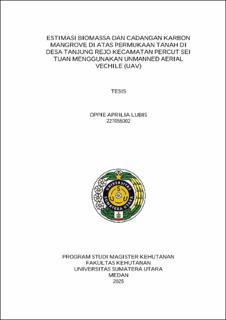Estimasi Biomassa dan Cadangan Karbon Mangrove di atas Permukaan Tanah di Desa Tanjung Rejo Kecamatan Percut Sei Tuan Menggunakan Unmanned Aerial Vechile (UAV)
Estimation of Aboveground Mangrove Biomass and Carbon Stocks in Tanjung Rejo Village, Percut Sei Tuan District Using Unmanned Aerial Vehicle (UAV)

Date
2025Author
Lubis, Oppie Aprilia
Advisor(s)
Thoha, Achmad Siddik
Slamet, Bejo
Metadata
Show full item recordAbstract
Global warming refers to increased CO2 in the atmosphere, which leads to climate
change and rising sea levels. Protecting mangrove forests is an effective way to
mitigate and adapt to the climate crisis. Mangroves act as absorbers of inorganic
carbon (CO2), converting it into organic carbon in the form of vegetation.
Mangrove ecosystems play a critical role in carbon storage as one of the most
carbon-dense ecosystems in the world. One of the efforts to mitigate climate change
is optimizing the role of mangroves in the photosynthesis process. Utilizing
Unmanned Aerial Vehicle (UAV) technology can efficiently assist in analyzing
carbon content in mangrove forests. The mangrove forests in Tanjung Rejo Village
are still relatively extensive, with moderate to high density, making it necessary to
study the potential of above-ground carbon storage. The objective of this study is
to estimate the above-ground biomass (AGB) of mangroves and the carbon stock
using UAV technology. Using UAV aerial imagery combined with geodetic GPS
measurements produces a high-accuracy Digital Surface Model (DSM) and Digital
Terrain Model (DTM). Mangrove canopy height is calculated by subtracting the
DTM from the DSM and then converting it into Lorey’s height. Field surveys are
also conducted to measure the diameter at breast height to derive Lorey’s height,
which is then converted into mangrove biomass. The tallest mangrove canopy in
Tanjung Rejo Village is 29 meters, located on the southwestern and northern edges
of the forest. The AGB and estimated mangrove carbon stock in Tanjung Rejo
Village range from 9 to 758 Mg/ha for AGB and 4 to 379 MgC/ha for carbon stock
estimation. With a study area of 21 hectares, the estimated above-ground carbon
storage potential in the study area is approximately 7,959 MgC.
Collections
- Master Theses [24]
